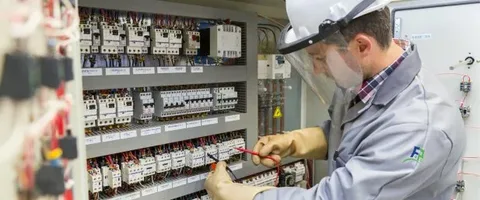A full-service electrical inspection thoroughly examines a home’s electrical system to check its safety, performance, and compliance. It starts by assessing the Electrical Inspection panel and checking wires and circuits to identify damaged parts. The electrician then tests outlets and switches for operational use and safety, and verifies that lighting is properly installed. The grounding and bonding systems and smoke and carbon monoxide detectors are also investigated. Professionals also inspect for surge protection and assess the home’s electrical load capacity, writing a full report with clear recommendations. These are the main components of electrical services that you need in order to ensure your home’s safety.
Table of Contents
Full-Service Electrical Inspection Checklist
Here is a checklist for a full-service electrical inspection:
1: Electrical Panel Inspection
The electrical panel (breaker box, distribution board) is the core of the home’s Electrical Inspection system.
- The electrician looks for overheating in the form of burn marks or melted insulation.
- They look for rust, corrosion, or signs of water damage on the panel.
- The panel is checked for labeling, verifying that each breaker corresponds correctly with specific appliances or areas.
- The electrician also inspects the panel to ensure it is sufficiently sized for the house’s present electricity usage and suggests a new panel if necessary.
2: Wiring and Circuit Checks
Wiring carries electricity throughout the house; old or broken wires can cause hazards such as electrical fires or sparks.
- The electrician examines the type and condition of visible wiring and checks for worn or frayed wires.
- Circuits are tested for sufficient grounding. The electrician checks that circuits are not overloaded to prevent overheating.
3: Outlet and Switch Testing
Switches and power points in all areas of the property are tested for correct operation and safety.
- Special tools and voltage testers verify that each outlet delivers electricity adequately and is grounded safely. Outlets are also tested to confirm they deliver power safely.
- GFCI (Ground Fault Circuit Interrupter) outlets, commonly located in the kitchen, bathroom, and outdoors, are checked to ensure they are in working condition.
- AFCI Protection (Arc Fault Circuit Interrupter) is also checked in bedrooms and other living spaces as recommended by modern Electrical Inspection codes.
4: Lighting Fixture Check
Proper lighting is essential for safety and functionality throughout the home. A home inspection includes checking each indoor and outdoor light fixture for code compliance and safety.
- Fixtures are inspected to ensure they are properly mounted and no wires are exposed.
- The electrician double-checks the bulbs’ wattage and ensures they don’t exceed the load capacity of the fixture.
- Circuits that supply the lighting are protected to meet the electrical code.
5: Checking the Grounding and Bonding System
Grounding and bonding are necessary for the safety of an electrical system. They create a route for surplus electricity to divert excess electricity (for example, during a lightning strike or fault current).
- The electrician checks that the electricity system is adequately grounded, using approved grounding rods or plates.
- Connectivity of the electrical and metal plumbing systems is intact to prevent shock.
- Tightness of connections to the grounding electrode conductor and other applicable equipment is verified.
6: Test Smoke and CO detectors
Safety devices are an important component of any complete electrical inspection.
- Smoke alarms are checked to ensure they are working and installed in each bedroom and level of the home.
- Carbon monoxide detectors are also checked, especially at homes with fuel-burning appliances.
- The inspector verifies that the devices are hardwired with battery backup (as per code).
7: Review for Electrical Code Compliance
The electrician will inspect the system to ensure it meets the National Electrical Code (NEC) and local codes. This includes looking for improper wiring, missing junction box covers, or unsafe DIY alterations. Those matters are flagged for correction if the current wiring setup was completed without permits or by unlicensed workers. They also flag outdated panel models, such as outdated Zinsco or Federal Pacific, which are unsafe for use.
8: Testing the Electrical Load and Capacity
The full-service inspection checks whether the system can power all appliances and electronics. It also determines whether the main panel’s amperage rating is sufficient, typically 100, 150, or 200 amps in most homes. They also recommend any future improvements, such as electric vehicle (EV) chargers, HVAC systems, or kitchen renovations, and whether the panel and service can handle them.
9: Final Report and Recommendations
Following the check, a written report is provided. This includes:
- A summary of findings, such as a hazard or code violation.
- Photos and descriptions of damaged areas.
- Suggested repairs, upgrades, or expert evaluation.
- A ranked list prioritizing urgent issues (say, fire hazards) or simple code updates.
Conclusion
A comprehensive electrical inspection provides a great way to detect hidden hazards and ensure your system’s optimal performance. Electricians check the panel and inspect all wiring, circuits, outlets, and switches for safety. They also inspect lighting fixtures for defects and ensure grounding and bonding systems are in place. Moreover, they test life-saving equipment such as smoke and carbon monoxide detectors, verify code compliance, and examine the home for surge protectors and proper operation.
They then evaluate your actual and potential load requirements and present you with a comprehensive written report. Every step of the process is crucial to ensuring your property’s safety, so take the time to invest in Electrical Inspection services as a preventative measure to keep your home running for years!
Explore more: Roofing Company Sacramento CA

